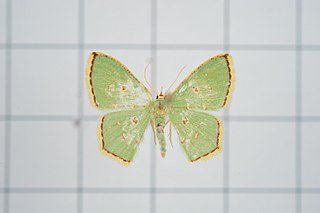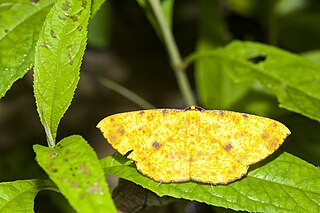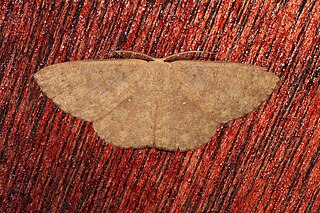
Though small in absolute diversity of genera, the Hemitheini are nonetheless the largest tribes of geometer moths in the subfamily Geometrinae. Like most Geometrinae, they are small greenish "emerald moths". The tribe was first described by Charles Théophile Bruand d'Uzelle in 1846.

Pelagodes is a genus of moths in the family Geometridae.

Symmacra is a monotypic moth genus in the family Geometridae described by Warren in 1896. Its only species, Symmacra solidaria, was first described by Achille Guenée in 1858. It is found in Indo-Australian tropics of India, Sri Lanka, Borneo east to Fiji, Samoa and Australia.

Orothalassodes falsaria is a species of moth of the family Geometridae. It is found in north-eastern India, Sri Lanka, China, Peninsular Malaysia, Sumatra, Borneo, Java and Bali. Records from Taiwan are misidentifications of Orothalassodes pervulgatus.

Celenna festivaria is a moth of the family Geometridae first described by Johan Christian Fabricius in 1794. It is found in India, Sri Lanka, Myanmar, Borneo, Java Taiwan, the Ryukyu Islands and Luzon in the Philippines.
Chorodna strixaria is a moth of the family Geometridae first described by Achille Guenée in 1858. It is found in India, Vietnam, Sulawesi, the Philippines, the Moluccas, New Guinea, Australia and Sri Lanka.

Comostola subtiliaria is a moth of the family Geometridae first described by Otto Vasilievich Bremer in 1864. It is a widespread species which is found in Korea and adjacent parts of Siberia, Japan, Borneo, Sumatra, India, South China, Taiwan, Borneo, Sumatra, and Sri Lanka.

Conolophia nigripuncta is a moth of the family Geometridae first described by George Hampson in 1891. It is found in Sri Lanka, the Indian subregion, Myanmar, Indochina and Borneo.

Eucyclodes semialba is a moth of the family Geometridae first described by Francis Walker in 1861. It is found in Sri Lanka, the north-east Himalayas of India, Myanmar and Sundaland.

Eumelea ludovicata is a moth of the family Geometridae first described by Achille Guenée in 1858. It is found in Indo-Australian tropics of India, Sri Lanka, east to Singapore, Taiwan, the Solomon Islands and Guam.
Gonanticlea occlusata is a moth of the family Geometridae first described by Felder in 1875. It is found in the north-eastern Himalayas of India, Sri Lanka, Tonkin, Peninsular Malaysia and Borneo.
Idaea semisericea is a moth of the family Geometridae first described by Warren in 1897. It is found in the north-eastern Himalayas of India, Sri Lanka, Borneo, Java and the Philippines.
Pelagodes furvifimbria is a species of moth in the family Geometridae first described by Prout in 1917. It is found in Sri Lanka.

Perixera absconditaria is a moth of the family Geometridae first described by Francis Walker in 1862. It is found in the Indian subregion, Sri Lanka, to Taiwan, Sundaland and the Philippines.

Spaniocentra pannosa is a moth of the family Geometridae first described by Frederic Moore in 1887. It is found in Sri Lanka.
Synegia imitaria is a moth of the family Geometridae first described by Francis Walker in 1861. It is found in Sri Lanka, India, Borneo, Peninsular Malaysia and Sumatra.

Thalassodes immissaria is a moth of the family Geometridae first described by Francis Walker in 1861. It is found in the Oriental tropics of China, India, Myanmar, Sri Lanka, Hong Kong, Japan, Borneo, Vietnam, Sumatra, Sulawesi and the Ryukyu Islands. The populations in Ryukyu were often classified as a subspecies - Thalassodes immissaria intaminataInoue, 1971. However, in 2005 this subspecies was upgraded to a distinct species, which can be distinguished from immissaria by careful examination of the male genitalia.
Thalassodes veraria, is a moth of the family Geometridae first described by Achille Guenée in 1858. It is found in Sri Lanka, Fiji, India, Java, Malaysia, New Guinea and Australia.

Anuga multiplicans is a moth of the family Noctuidae first described by Francis Walker in 1858. It is found in India, Sri Lanka, Hong Kong, Korea, Taiwan, Philippines and Borneo.
Paradiopa postfusca is a moth of the family Noctuidae first described by George Hampson in 1893. It is found in Sri Lanka and India.












